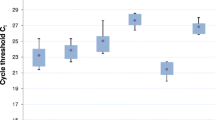Abstract
Objectives
Non-steroidal anti-inflammatory drugs play a major role in the management of osteoarthritis (OA). However, it remains unknown whether these drugs affect cartilage and synovial metabolism in osteoarthritic joints. The aim of this study was to evaluate the effects of a selective cyclooxygenase (COX)-2 inhibitor, celecoxib, on synovial fluids and tissues in severely osteoarthritic knees.
Methods
Patients were randomized into three groups and medicated two weeks prior to total knee arthroplasty with celecoxib, diclofenac sodium, or no medication (control). We checked for the presence of matrix metalloproteinase-3 (MMP-3), tumor necrosis factor-α (TNF-α), interleukin-1β (IL-1β), and hyaluronic acid (HA) in the synovial fluids of all three groups.
Results
MMP-3 significantly decreased in the celecoxib-treated patients (p = 0.0031). On the other hand, there were no significant differences among the three groups in their TNF-α and IL-1β levels. HA in the joint fluid was significantly increased in the diclofenac-treated group, while HA was not changed in the celecoxib-treated patients.
Conclusions
Our study suggests that celecoxib did not affect the level of HA in the joint fluid in the knee in severe OA, in contrast to the effect of the dual COX inhibitor.




Similar content being viewed by others
References
Zhang W, Moskowitz RW, Nuki G, Abramson S, Altman RD, Arden N, Bierma-Zeinstra S, Brandt KD, Croft P, Doherty M, Dougados M, Hochberg M, Hunter DJ, Kwoh K, Lohmander LS, Tugwell P. OARSI recommendations for the management of hip and knee osteoarthritis, part I: critical appraisal of existing treatment guidelines and systematic review of current research evidence. Osteoarthr Cartil. 2007;15:981–1000.
Mastbergen SC, Jansen NWD, Bijlsma JJW, Lafeber FP. Differential direct effect of cyclo-oxygenase 1/2 inhibition on proteoglycan turnover of human osteoarthritic cartilage: an in vitro study. Arthritis Res Ther. 2006;8(R2):1–9.
de Boen TN, Huisman AM, Polak AA, et al. The chondroprotective effect of selective COX-2 inhibition in osteoarthritis: ex vivo evaluation of human cartilage tissue after in vivo treatment. Osteoarthr Cartil. 2009;17:482–8.
Siegle I, Klein T, Backman JT, Saal JG, Nüsing RM, Fritz P. Expression of cyclooxygenase 1 and cyclooxygenase 2 in human synovial tissue: differential elevation of cyclooxygenase 2 in inflammatory joint diseases. Arthritis Rheum. 1998;41:122–9.
Altman R, Asch E, Bloch D, Bole G, Borenstein D, Brandt K, Christy W, Cooke TD, Greenwald R, Hochberg M, et al. Development of criteria for the classification and reporting of osteoarthritis. Classification of osteoarthritis of the knee. Diagnostic and Therapeutic Criteria Committee of the American Rheumatism Association. Arthritis Rheum. 1986;29:1039–49.
Yamanaka H, Matsuda Y, Tanaka M, Sendo W, Nakajima H, Taniguchi A, Kamatani N. Serum matrix metalloproteinase 3 as a predictor of the degree of joint destruction during the six months after measurement, in patients with early rheumatoid arthritis. Arthritis Rheum. 2000;43:852–8.
Sahap Atik O. Leukotriene B4 and prostaglandin E2-like activity in synovial fluid in osteoarthritis. Prostaglandins Leukot Essent Fatty Acids. 1990;39:253–4.
Hardy MM, Seibert K, Manning PT, Currie MG, Woerner BM, Edwards D, Koki A, Tripp CS. Cyclooxygenase 2-dependent prostaglandin E2 modulates cartilage proteoglycan degradation in human osteoarthritis explants. Arthritis Rheum. 2002;46:1789–803.
Wang CT, Lin YT, Chiang BL, Lin YH, Hou SM. High molecular weight hyaluronic acid down-regulates the gene expression of osteoarthritis-associated cytokines and enzymes in fibroblast-like synoviocytes from patients with early osteoarthritis. Osteoarthr Cartil. 2006;14:1237–47.
Elliott AL, Kraus VB, Luta G, Stabler T, Renner JB, Woodard J, Dragomir AD, Helmick CG, Hochberg MC, Jordan JM. Serum hyaluronan levels and radiographic knee and hip osteoarthritis in African Americans and Caucasians in the Johnston County Osteoarthritis Project. Arthritis Rheum. 2005;52:105–11.
Pavelka K, Forejtová S, Olejárová M, Gatterová J, Senolt L, Spacek P, Braun M, Hulejová M, Stovícková J, Pavelková A. Hyaluronic acid levels may have predictive value for the progression of knee osteoarthritis. Osteoarthr Cartil. 2004;12:277–83.
Sztrolovics R, Recklies AD, Roughley PJ, Mort JS. Hyaluronate degradation as an alternative mechanism for proteoglycan release from cartilage during interleukin-1beta-stimulated catabolism. Biochem J. 2002;362(2):473–9.
Flannery CR, Hughes CE, Schumacher BL, Tudor D, Aydelotte MB, Kuettner KE, Caterson B. Articular cartilage superficial zone protein (SZP) is homologous to megakaryocyte stimulating factor precursor and Is a multifunctional proteoglycan with potential growth-promoting, cytoprotective, and lubricating properties in cartilage metabolism. Biochem Biophys Res Commun. 1999;27:535–41.
Chockalingam PS, Zeng W, Morris EA, Flannery CR. Release of hyaluronan and hyaladherins (aggrecan G1 domain and link proteins) from articular cartilage exposed to ADAMTS-4 (aggrecanase 1) or ADAMTS-5 (aggrecanase 2). Arthritis Rheum. 2004;50:2839–48.
Mastbergen SC, Bijlsma JW, Lafeber FP. Selective COX-2 inhibition is favorable to human early and late-stage osteoarthritic cartilage: a human in vitro study. Osteoarthr Cartil. 2005;13:519–26.
El Hajjaji H, Marcelis A, Devogelaer JP, Manicourt DH. Celecoxib has a positive effect on the overall metabolism of hyaluronan and proteoglycans in human osteoarthritic cartilage. J Rheumatol. 2003;30:2444–51.
Jiang D, Zou J, Huang L, Shi Q, Zhu X, Wang G, Yang H. Efficacy of intra-articular injection of celecoxib in a rabbit model of osteoarthritis. Int J Mol Sci. 2010;21:4106–13.
Alvarez-Soria MA, Largo R, Santillana J. Long term NSAID treatment inhibits COX-2 synthesis in the knee synovial membrane of patients with osteoarthritis: differential proinflammatory cytokine profile between celecoxib and aceclofenac. J Ann Rheum Dis. 2006;65:998–1005.
Acknowledgments
This work was supported by a grant-in-aid for science research from the Japanese Ministry of Education, Culture, Sports, Science and Technology (C-21500399, Hohga-23659703)
Conflict of interest
None.
Author information
Authors and Affiliations
Corresponding author
About this article
Cite this article
Takahashi, D., Majima, T., Onodera, T. et al. Celecoxib does not affect the release of hyaluronic acid in end stage osteoarthritic joints. Mod Rheumatol 23, 934–938 (2013). https://doi.org/10.1007/s10165-012-0772-0
Received:
Accepted:
Published:
Issue Date:
DOI: https://doi.org/10.1007/s10165-012-0772-0




